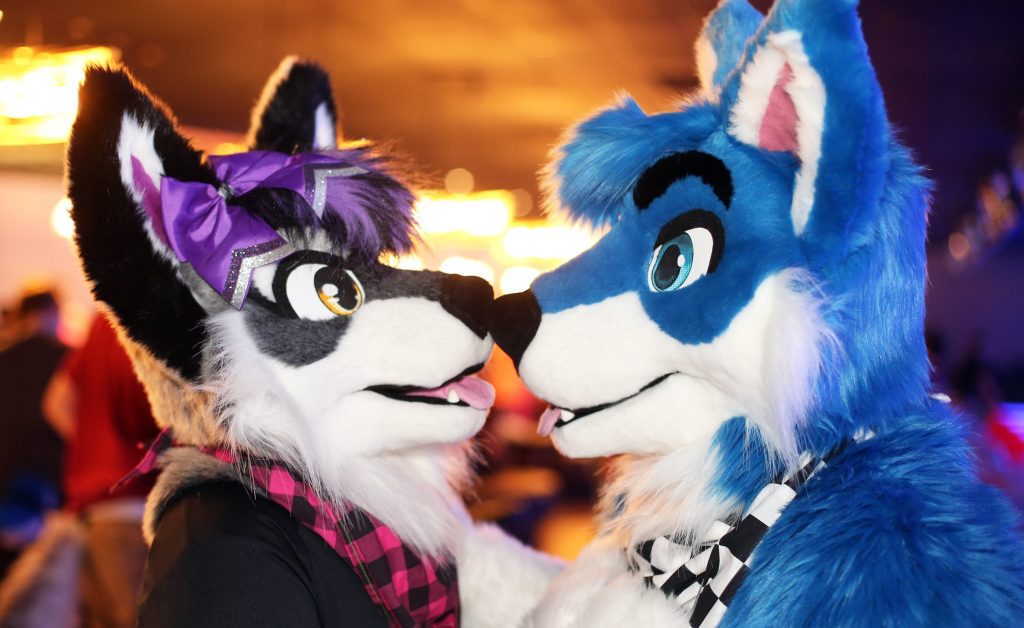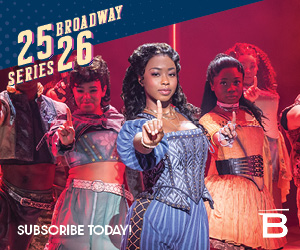Furries share passions for animals, philanthropy, and acceptance
By Jane Latus / Photography by TODD FAIRCHILD and STAN GODLEWSKI
If you go down to the woods today, you’re sure of a big surprise. Especially if the woods are in Manchester’s Wickham Park, because today is the day the teddy bears – and otters, foxes, mice, cats, dragons, rabbits and leopards – have their picnic. It’s a gorgeous June Saturday for the 6th Furry Picnic, and nearly 150 furries of all ages are there, some in fursuits and others wearing tails, paws, ears, masks, or a badge with an artist’s depiction of their furry self.
Family-reunioners in nearby pavilions are in for a treat. “What is this?!” they say as they wander over to see fuzzy, colorful, critters barbecuing and throwing Frisbees. Some end up joining in, says picnic organizer Kasi Frost of Bristol (aka Vulpes Automata, an arctic fox). And why wouldn’t they? Being a furry is fun. It is also, furries say, life-changing. “Who doesn’t wish to be sly like a fox, roar like a lion, and howl like a wolf?” says Kar, a purple-eyed gray wolf (Jon McMurray, formerly of New Britain and now Maryland) who credits being a furry with easing his social anxiety and a new way of life. “I’ve definitely made lifelong friends,” he says, including “people I tell stuff to I never would have told anyone in a million years.”
Before, says Kar, “I hardly went outside. I went to work, home, bed, repeat. Now I’m going out a whole lot and am excited about going out. It changed my life. It’s definitely about having friends, but it’s also about having a support network. It’s also how I met my partner.” The picnic is annual, as are two other Connecticut events. In August, furries meet at Camp Tiny Paws in Danbury for crafts and summer camp fun. Every October, approximately 1,400 furries convene in Cromwell for Furpocalypse. But furries are a social bunch. You’ll frequently find them eating at Town Line Diner in Rocky Hill, bowling at Spare Time in Bristol, or going for spur-of-the-moment walks. Passersby do double-takes, and kids run up asking for hugs.

Furries are …
Furries are fans of anthropomorphic animals, portrayed in community-created media including drawings, video games, costumes, animé, music, fiction and usually a fursona that expresses an extension of themselves. Kar “gravitated to wolves because I have a very strong sense of friends and packs. That’s what I always wanted growing up, so that’s naturally what I settled on.” Flash Bluewolf of Meriden (who prefers not to use his real name) describes his fursona as “a carefree wolf who’s fun and easygoing. My fursona is my goal. In literal life I’m not this, but this is how I want people to see me.”
Furries are similar to cosplayers, Comic-Con goers, Trekkies and sports fans, but are – no offense to the others – more creative; they produce their own content. Furries are more participatory. And the community grew by decentralized organizing, rather than in response to a big-name show or movie. Furries are also predominantly LGBTQ, not surprising for a group that values originality. Plus, if you already accept others’ identities, extending that to their interests – say, dressing like a dragon – isn’t a reach. Says Vex Zorro, a blue, black and purple fox (Jeremy Gagnon of Massachusetts), “I can be myself. I can relax without having to worry about being discriminated against, a fear I had when I first realized I was gay.”
Ask furries to describe their community, and they hit on these major themes: love of animals, art, charity and friendship. Voxel (who chooses not to use his real name), a red and black fox from Massachusetts who attends many furry events in his native Connecticut, explains: “Beyond having people to share the general interest of anthropomorphic animals with, I like that it’s full of gender and sexual minorities. That alone makes me feel more welcome in this community. Interacting with other furries has made me a less socially anxious person,” which has spilled over into the rest of his life, he adds. “It’s made me a more confident person.”
He says, “The other thing I like about the fandom is it’s so artistic, so creative in many ways. You get to know lots of talented people, like artists and dancers. Also, there’s the whole charity aspect. “It’s more enriching than I’d expected,” he continues. He goes out a lot now, to barbecues, walks and bowling. Tomorrow, he says, he’s picking up an Ikea bed frame and will try to assemble it himself. “If not, I’ll need to enlist a local furry!” Furries share many stories of helping each other, from mentoring to crises. “You have a community that cares whether you succeed,” says Frost.

Learning the Lingo
There are some useful terms for normies (non-furries) to know:
Furry fandom: the furry community
Fursona: a self-created animal character with whom one identifies, often designed around real or idealized aspects of themselves, and used as an avatar
Mates: romantic partners or spouses
Gray muzzles: senior furries
Badge: a drawing, worn on a lanyard, depicting one’s fursona
Fursuit: a costume representing one’s fursona, worn by only about 20 percent of furries because they are expensive and, face it, hot.
Also expect furries to use terms of measurement like “pawful.”
Furry Business
Many furries say their first convention is unforgettable. “I loved it, right away, from the very moment we drove into the parking lot,” says Kar. “Until that point, it was a closeted part of my life. Seeing lots of people dressed up, being themselves and not having a care in the world about it …” Vex Zorro says, “I saw my first fursuit, and it was the best thing ever. I love animals, and to see an animal like that, it gave me much more joy than I’d ever felt before.” Conventions showcase furry-made art, and careers are made here. “There’s a massive fan base of people who want to see the art. Works go for thousands of dollars just within our little fandom,” says Tiffany Fox of Bristol, aka domestic cat Taisia. Fox, married to Frost, is herself an artist. There’s also fun with a fuzzy twist: imagine adults, in fursuits, playing musical chairs, dancing onstage, and parading by the hundreds through hotel halls. Furpocalypse raises money for the U.S. War Dogs Association, a military service dog welfare group, and True Colors, which advocates for sexual and gender minority youth. Camp Tiny Paws and the Furry Picnic focus on the Humane Society. “Those two organizations over the past three years have raised over $3,000 for the Connecticut Humane Society out of the goodness of their hearts,” says Priscilla Clark, society development manager. “I feel like we’ve become part of the furry community.”
A furry’s calendar can get crowded. Vex Zorro attended nearly 100 New England events in 2018. With an impressive commitment to frequency and variety, furries meet for go-carts, movies, walks, mini golf, picnics, conventions, backyard barbecues, car meets, board games, bowling, dinners, ham radio operating, roller skating and camping. There’s a misconception that “we sit at home online,” says Fox. “No, we go out and do things!”

Feeling the Impact
Many furries say they used to be lonely, anxious or shy. “It caused a monumental change in my life – my personality, my comfort in socializing. It gave me self-esteem,” says Flash. “I’m a college educated, world-traveled, intelligent young man but people looked at me like I was just a kid. Being a furry helped me stand up. I feel like an adult.” He was miserable at work and had the courage to find a new job he loves. “When I went in for that interview, I nailed it! It felt so new because it wasn’t how I used to be.” As a bonus, Flash met his boyfriend through the community. The support is empowering, says Frost. “It’s not taboo to be you, to be everything that you are. We are fans of ourselves.” The International Anthropomorphic Research Project is a team of scientists who compile furry data. They report increased well-being among those who were previously bullied, despite that “our studies also show that other fan groups dislike furries.” They found: 80 percent of furries are LGBTQ, 84 percent are male, 88 percent of adults are under 30 (they didn’t track minors), and 40 percent feel furries aren’t socially accepted.
Furries say Connecticut’s community is likewise mostly young gay men, but more diverse than elsewhere, especially with a growing number of trans furries, thanks to local efforts at inclusivity. Picnickers ranged from nine-year-old Super BunBun of Middletown (a chocolate bunny with a turquoise tummy) to gray muzzles and straight couple Tony and Tara Bassette (Miss Cellaneous Mouse) of Colchester. But forget real life – what are the popular fursonas? The data say: hybrid, wolf, fox, dog, big cat, dragon, mythical, cat, rodent, rabbit, raccoon, reptile, otter, avian, bear, horse, aquatic, hyena, skunk, marsupial, dinosaur, deer, feline, squirrel, ferret, canine and insect.
Famous Furry
Normies were introduced to a furry last year when Dominique McLean won the eSports Player of the Year award. He may not have made headlines if he hadn’t worn his SonicFox fursuit and announced, “I’m gay, I’m black, a furry, pretty much everything a Republican hates.” Kar, laughing, says furries are at the bottom of the fan-group hierarchy, “Which I’ve always found funny. People who go to Star Trek conventions think we’re weird.” Says Vulpes, “These are just really passionate people who love art and fun, and give tons of money to charitable organizations.” Want to get your furry on? The fandom is an (anthropomorphic) mouse click away, and there’s no need for a tail. Says Frost, “It’s not always about the costume. It’s who you are in your heart.”









More Stories
Diving in with Greg Louganis
Back to School Out and Proud
Pilobolus is Changing Shape with LGBTQ+ Dancers